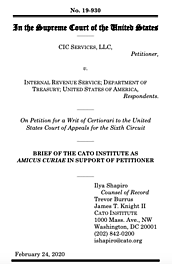Learn more about Cato’s Amicus Briefs Program.
Although the IRS is responsible for collecting taxes, the power to write tax law is a legislative power held by Congress. Congress writes the tax laws and charges the IRS with enforcement and collection duties. In certain cases, however, Congress has delegated to the IRS limited authority to fill in the gaps of tax laws through regulation. The Administrative Procedure Act (APA) lays out the processes that agencies such as the IRS must follow when promulgating regulations, such as allowing for a period of public comment on proposed regulations. Unfortunately, the IRS has habitually refused to comply with the APA absent the intervention of the courts. The APA, however, provides a remedy for such situations: pre-enforcement judicial review. This process allows an individual or entity to challenge the validity of a regulation that could affect it in court without having to first violate the regulation and risk the often severe consequences that would follow.
CIC Services, which advises taxpayers on certain types of complex transactions, is using pre-enforcement judicial review to challenge the validity of an IRS reporting requirement that it claims is invalid because the IRS evaded the regulatory procedures required by the APA. The IRS, however, is attempting to use a law called the Tax Anti-Injunction Act (AIA) to block the challenge and prevent CIC’s serious legal arguments from even being heard. The AIA prohibits challenges to a tax before the tax has been collected. In most instances, a person challenging a tax assessment must first pay the tax and then file a claim for a refund. CIC’s challenge, however, is not to the tax but rather to the validity of the regulatory rule passed by the IRS.
The IRS narrowly prevailed in the Sixth Circuit when two judges of three-judge panel held that CIC couldn’t challenge the regulation because of the AIA. The court held that the penalty triggered by failing to follow the new reporting requirement was a tax, thus subjecting the lawsuit to the AIA. In doing so, the Sixth Circuit widened a circuit split by following the reasoning of the D.C. Circuit but diverging from the Seventh and Tenth Circuits’ decisions to the contrary (Cato filed a brief in support of a petition for certiorari in the D.C. Circuit case but the Supreme Court declined to take it up). Under the Sixth Circuit’s reasoning, the only recourse against defective Treasury regulations is to purposely violate the regulation and incur increased taxes, penalties, and interest while waiting for a subsequent enforcement proceeding in which the regulation’s validity can be challenged.
Cato has filed an amicus brief in support of Supreme Court review. The AIA’s statutory language should be interpreted as the Supreme Court has interpreted the Tax Injunction Act (TIA)—confusing, but not the same law—because they contain almost exactly the same language. Under the TIA, one cannot challenge a regulation that deals with either the “assessment” or “collection” of taxes. Similarly, we argue, the AIA only prohibits challenges that have the “purpose” to “restrain” “assessment” or “collection” of a tax. Since the fine at issue is a penalty for regulatory non‐compliance rather than a tax, the AIA shouldn’t bar judicial challenges.
Moreover, the Sixth Circuit’s interpretation creates an unnecessary conflict between the AIA and the APA. The APA contains a “strong presumption” of judicial review prior to enforcement of substantive regulations like the one at issue here. Congress intended that all agencies’ substantive regulations would be subject to such review under the APA, and it certainly didn’t intend for the IRS to be almost immune from accountability before federal courts. People have a right to be sure of a regulation’s meaning before engaging in costly compliance efforts, and that’s exactly what pre‐enforcement judicial review provides.
The APA contains stringent procedural requirements for how regulations are to be promulgated. The IRS frequently ignores these requirements and must be reined in. The Supreme Court should take up this case and reverse the lower court’s dangerous precedent.

This work is licensed under a Creative Commons Attribution-NonCommercial-ShareAlike 4.0 International License.



